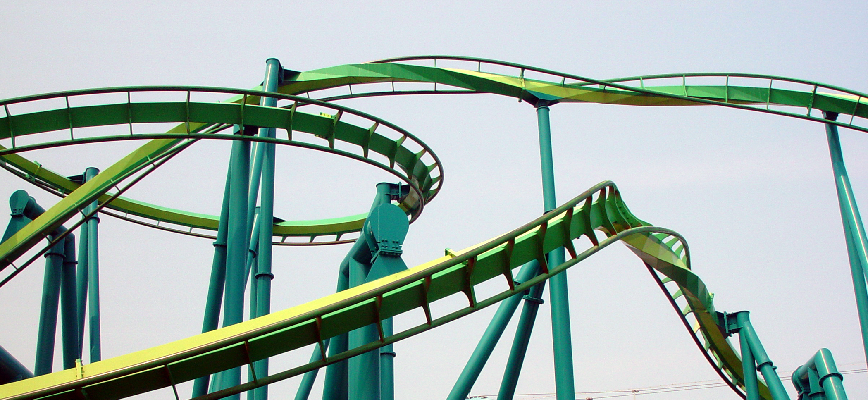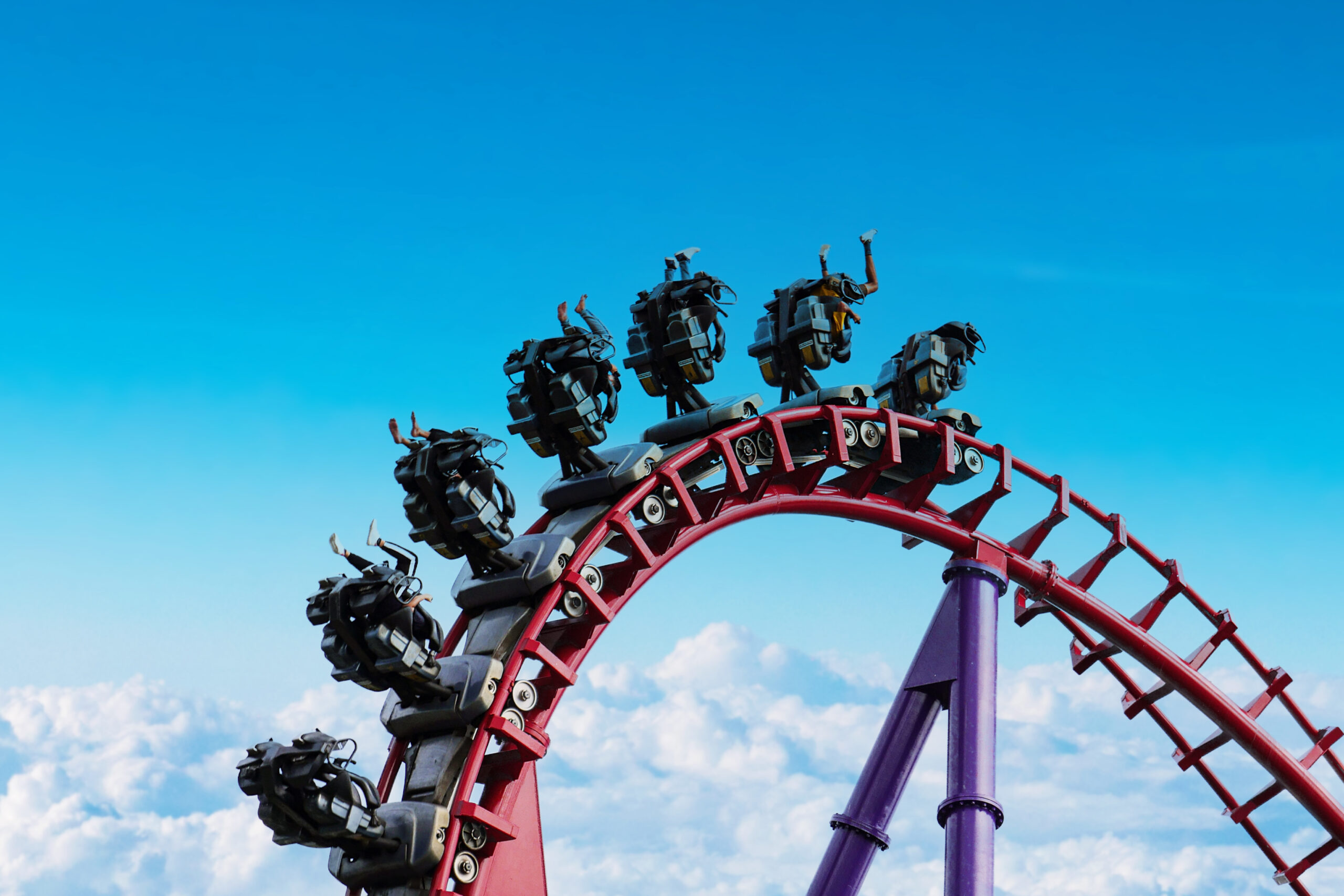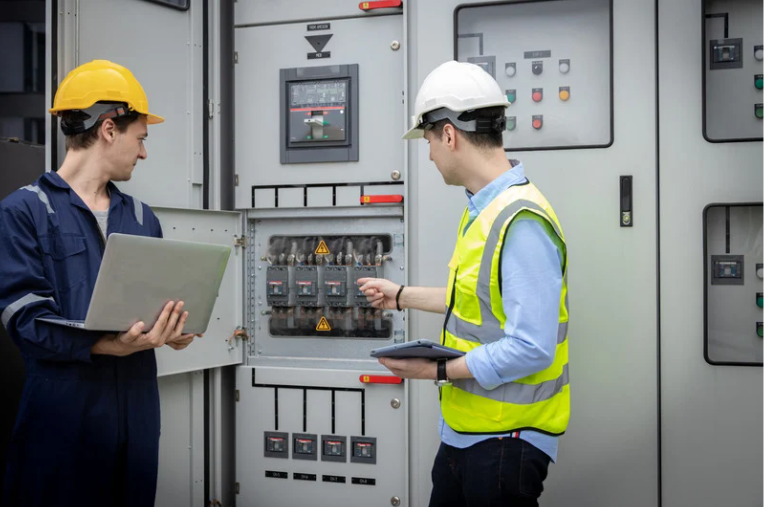Millions of people flock excitedly to theme parks every year to revel in the adrenaline rush that is provided by riding roller coasters and an array of other exhilarating rides. As we queue for the our chosen ride we try to remain calm as it goes hurtling by and the echo of the riders screams ring in your ears. As the queue moves closer to the front, nearer to you taking your turn your heart rate increases and the nerves kick in.
So why is it then that we do this to ourselves?
It is the thrill seekers that are attracted in their droves to roller coasters, rather than those personalities that prefer the quiet life. They are certainly not for everyone.
Theme parks and roller coasters are a way of breaking out of life’s “normal” routine. There is just something exhilarating about being able to scream at the top of your lungs and it being ok. The experience of a roller coaster also has a strange way of bringing people together, sharing in the thrills of surviving the extreme experience.
How safe are rollercoasters?
With the Smiler roller coaster crash at Alton Towers still fresh in the mind of the British public, it can only make you wonder how safe roller coasters really are. Very, is the answer!
Roller coasters are generally safe when they are designed, built, and maintained according to strict safety standards and regulations. Theme parks and amusement ride manufacturers adhere to safety guidelines set by organisations like ASTM International and the International Association of Amusement Parks and Attractions (IAAPA). These guidelines cover various aspects, including ride design, manufacturing, operation, and maintenance.
The safety of roller coasters is ensured through rigorous inspections, testing, and routine maintenance. Roller coasters undergo regular inspections by trained professionals, and any issues identified during these inspections are addressed promptly. Additionally, theme parks have their own maintenance teams that conduct daily checks and perform routine maintenance to ensure the rides are in optimal condition.
How often do roller coasters malfunction?
The frequency of roller coaster malfunctions can vary, and it’s important to note that roller coasters are designed and maintained with a strong emphasis on safety. Serious malfunctions are rare due to stringent safety standards, regular inspections, and maintenance procedures implemented by amusement park operators.
Why do roller coasters malfunction?
What causes roller coasters to experience malfunctions? Attractions such as roller coasters and other exhilarating rides depend on intricate machinery, which may malfunction if not adequately maintained. For instance, riders on roller coasters might encounter sudden stops resulting from brake failures or, in more severe cases, derailment due to structural problems with the tracks.
What are the common causes of roller coasters malfunctioning?
Roller coaster malfunctions are rare, although they can occur for a number of causes, including technical problems, human error, extreme weather, and even intentional harm. It’s important to stress that these incidents are unusual and do not represent roller coaster safety standards generally.
Here are some examples of roller coasters malfunctioning
-
Rollbacks
You might be familiar with the occasional mishaps on rides like Kingda Ka and Top Thrill Dragster. These vertical lift attractions push the boundaries of physics to their extremes, and occasionally, physics fights back. Roller coasters with launch mechanisms often have warning signs advising riders to stay calm if they witness the rare sight of a heavy coaster cart unexpectedly moving backwards at a significant speed. It’s akin to asking someone not to feel an adrenaline rush during an unexpected event. Nevertheless, these incidents do occur, and exploring the reasons behind them is intriguing.
Rollbacks happen when a coaster train launches at a speed insufficient to reach the top of the track. Once the cart surpasses the initial challenge, Newton’s Laws of Motion take control. The challenge lies in propelling the massive coaster cart, currently in a state of inertia, to the required velocity for a straight ascent over 400 feet. If it were a simple task, Kingda Ka wouldn’t leave everyone awestruck.
What causes rollbacks?
Rollbacks can be caused by a variety of circumstances, but three obvious offenders come to mind. The most obvious is bad weather, especially with strong gusts. Gusts have the ability to alter the launch velocity, and as Olympic luge and bobsledding events have shown, each microsecond of initial velocity has a ripple effect on the entire course of the race. Rollbacks can occur with as little as a few miles per hour of decreased speed.
2. Roller coaster safety triggers
Another primary reason for a ride to malfunction is frequently the programmable logic controllers’ detection of defects, which triggers a failsafe. Unexpectedly, this happens more often than one may think. Think of it like your smartphone, tablet, or PC. How many times have you needed to reboot your device because it became unresponsive? Because most attractions run on a vast computer network, they are susceptible to similar problems, but on a bigger scale.
When you ride a modern roller coaster, the ride’s equipment continuously makes complex calculations at every turn and even on the straight sections. Several processors examine input and output processes; they must all confirm that the ride is running at maximum efficiency in order to permit its advancement. As a result, if you find yourself stuck on a ride that has malfunctioned, it’s probably because a computer check detected a RIDE ERROR notice. If it’s not just a random computer glitch, you should be grateful for the circumstances. It might have saved you from becoming an extremely unlikely and really bad statistic when it comes to amusement park mishaps.
Do roller coasters have safety regulations?
Indeed, there are regulations and standards established by local authorities and industry organizations to oversee the safety of roller coasters. These regulations encompass various facets, including ride design, construction, operation, and maintenance. Amusement parks are obligated to adhere to these regulations to guarantee the safety of their patrons.
How rare are roller coaster accidents?
One in 24 million! Incidents on roller coasters and amusement rides are exceptionally uncommon. According to the International Association of Amusement Parks and Attractions, the likelihood of sustaining an injury on an amusement park ride is one in 24 million
What are the chances of getting hurt on a roller coaster?
The chances of getting hurt on a roller coaster are generally very low when riders follow safety guidelines and adhere to the rules set by the amusement park. Roller coasters are designed with safety as a top priority, and strict regulations and standards are in place to minimize the risk of injuries.
However, it’s important to consider individual health factors and adhere to ride restrictions. Certain health conditions, such as heart problems, back issues, or pregnancy, may warrant avoiding certain rides. Additionally, riders should be aware of and follow any height, age, or weight restrictions set by the park for each attraction.
Most injuries that do occur on roller coasters are typically minor and can result from factors such as not securing personal belongings, ignoring safety instructions, or engaging in unsafe behavior during the ride. It’s crucial for riders to listen to ride operators, follow posted safety guidelines, and use safety restraints properly.
What are the chances of dying on a roller coaster?
According to the Association of Amusement Parks and Attractions, the chances of dying on a roller coaster fall between 1 in 24 million.
Is it possible to fall out of a roller coaster?
While extremely rare, it is theoretically possible for someone to fall out of a roller coaster. Roller coasters are designed with multiple safety features, including secure restraints, to prevent such incidents. Strict safety standards, regular inspections, and maintenance contribute to minimising the risk. Following ride guidelines and restrictions is essential for rider safety.
Where is the safest place to sit on a rollercoaster?
The safest place to sit on a roller coaster is typically in the middle of the train, near the centre of gravity. This area tends to experience less extreme forces compared to the front or back seats. However, all seats on a well-maintained and properly designed roller coaster should be safe. It’s essential to follow the ride’s guidelines and any provided instructions for a secure and enjoyable experience.
What happens if a roller coaster rolls back?
If a roller coaster experiences a rollback, it means that it fails to complete the intended course and rolls backwards along the track. Roller coasters are designed with safety mechanisms to prevent rollbacks, but in the rare event that it occurs, the coaster is equipped to handle it safely. Roller coaster systems often have features such as anti-rollback devices, catch cars, or magnetic brakes to prevent rollbacks.
If a rollback occurs, the ride’s safety systems are designed to bring the coaster to a controlled stop, and it will be assessed by park staff. Passengers are typically unharmed, and the ride will be thoroughly inspected before resuming operations. Roller coasters undergo stringent testing and safety checks to minimise the likelihood of rollbacks and ensure the well-being of riders.
What are the chances of a roller coaster accident
What are the most common causes of roller coaster accidents?
Serious roller coaster accidents are relatively rare, and modern roller coasters are designed with multiple safety features. However, when accidents do occur, they are often attributed to the following factors:
Mechanical Failure: Malfunctions in the ride’s mechanical components, such as wheels, brakes, or restraints, can lead to accidents. Regular maintenance and inspections are crucial to prevent mechanical failures.
Human Error: Operator errors, either during the operation or maintenance of the roller coaster, can contribute to accidents. Strict training procedures and adherence to safety protocols help mitigate this risk.
Rider Behavior: Failure to follow safety guidelines, intentionally disregarding ride instructions, or attempts to circumvent safety features can result in accidents. It’s important for riders to follow all rules and guidelines for their own safety.
Design Flaws: In rare cases, accidents may be caused by flaws in the ride’s design or engineering. This highlights the importance of thorough testing and adherence to safety standards during the design and construction phases.
Weather Conditions: Extreme weather conditions, such as high winds or lightning, can pose a risk to roller coaster safety. Parks typically close rides in adverse weather to ensure rider safety.
It’s important to note that advancements in technology, rigorous safety standards, and strict regulations have significantly reduced the occurrence of roller coaster accidents. Theme parks and ride manufacturers prioritise safety through regular inspections, maintenance, and adherence to industry guidelines.
What are the odds of a roller coaster crashing?
The International Association of Amusement Parks and Attractions (IAAPA) has been compiling national information on rollercoaster safety since 2001. It suggests that the chances of being killed on a rollercoaster are just one in 170 million,
What are the chances of getting injured on a roller coaster?
The International Association of Amusement Park (IAAAPA) suggests that the odds of sustaining an injury at a theme park is one in 9 million and the chances of being injured actually on a ride are one in 24 million. In fact, you are more likely to be injured travelling to a theme park than whilst you are there.
What happens when things go wrong?
Our UK theme parks are enviably the safest in the world. Our safety is certainly not taken lightly however, accidents still do happen.
In the case of the Smiler, where two of the cars collided at 20 mph, the theme park immediately closed down. This was to enable investigations into the cause of the crash to take place and to give the staff time to come to terms with the accident and its posts events.
Any accident automatically triggers a review of safety procedures regardless of the industry. This was no different for the Merlin Group that owns Alton Towers. Of course, the safety procedure will also be scrutinised as part of the litigation cases and personal injury claims against the company.
What of the Victims?
As well as some of the safest theme parks in the World we also have a justice system that allows everyone access to the law. Litigation funding will be available to the victims of the accident. This means that the cases can be brought to court without the victims having to fund them, to take such a large company to court could be very costly. Although, in the case of Alton Towers they have admitted full liability, the case for them will be a costly one, but not necessarily a lengthy one.
Although covered by law for accidents on rides and in theme parks, the winning of a case will certainly not bring back people from fatalities or make up for life changing injuries. So, weigh up the risks that you take every day in life.
Will accidents like the Alton Towers Smiler crash stop me going to a theme park or riding a roller coaster?
No! I am one of life’s risk takers and thrill seekers, although one day I hope to prefer the quieter qualities of life.
How about you? Let me know in the comments.



Be the first to comment on "What are the chances of a roller coaster crash?"